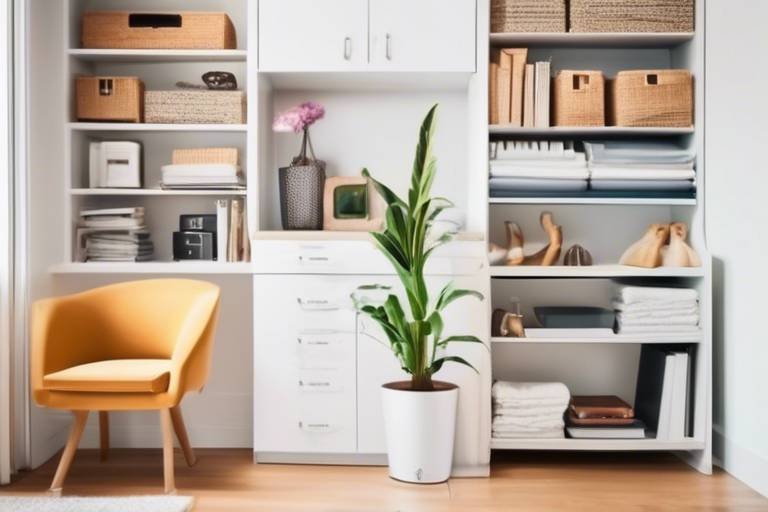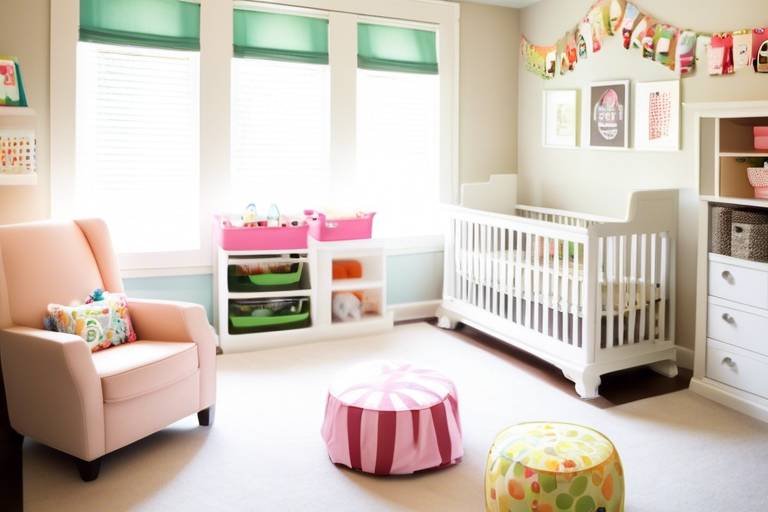Balancing Family Life While Working from Home
In today's fast-paced world, many of us find ourselves juggling the demands of a career while also being present for our families. The rise of remote work has brought this challenge to the forefront, as we strive to maintain our productivity without sacrificing quality time with our loved ones. So, how can we effectively manage both our professional responsibilities and family commitments? The answer lies in adopting practical strategies that create a harmonious balance between work and home life. In this article, we will explore various techniques to help you navigate this intricate dance, ensuring that you can excel in your job while cherishing moments with your family.
Creating a consistent daily schedule is crucial for balancing work and family life. Imagine your day as a well-orchestrated symphony, where each instrument plays its part harmoniously. By setting up a routine that accommodates both professional tasks and family commitments, you can ensure that neither aspect of your life overwhelms the other. Start by identifying your peak productivity hours—when do you feel most energized and focused? Schedule your most demanding work tasks during these times, leaving the quieter moments for family interactions, meals, or even a quick game with the kids. This way, you’re not only maximizing your efficiency but also carving out precious time for your family.
Having a dedicated workspace can significantly enhance focus and productivity. Think of your workspace as your personal command center—a place where you can dive deep into your work without the distractions of home life. Here are a few tips for selecting and organizing an area in your home that fosters a professional environment:
- Choose a quiet corner away from the hustle and bustle of family activities.
- Ensure your workspace is equipped with all the necessary tools to perform your job efficiently.
- Consider the lighting; natural light can boost your mood and energy levels.
By minimizing distractions and creating an environment that promotes focus, you’ll find it easier to transition between your professional and personal roles.
Engaging family members in the workspace setup can create a sense of ownership and understanding. When your family is involved, they are more likely to respect your work time. You might ask your children to help choose decorations or even create a fun sign that indicates when you're in a meeting. This involvement not only makes your workspace feel more personalized but also fosters a sense of teamwork within the family.
The location of your workspace can impact productivity significantly. For instance, setting up your office in a high-traffic area may lead to constant interruptions. Instead, consider factors such as:
- Proximity to family members
- Noise levels
- Access to necessary resources like printers or supplies
Finding the right spot can be the difference between a productive day and one filled with distractions.
Adding personal touches to your workspace can improve motivation and make the environment feel more inviting. Incorporate elements that inspire you, such as:
- Photos of family and friends
- Quotes that resonate with you
- Plants to bring a bit of nature indoors
While it’s important to maintain a professional atmosphere, a few personal items can significantly uplift your spirits and keep you motivated throughout the day.
Establishing clear boundaries between work and family time is vital for maintaining balance. Communicate your work hours to your family, and let them know when you’re available for family activities. It’s crucial to stick to these boundaries, just as you would in a traditional office setting. You might even create a visual cue, like a “do not disturb” sign, to help family members understand when you need uninterrupted time.
Maintaining open lines of communication with family is essential for balancing work and home life. Regularly discuss your schedules and expectations with your loved ones. This creates an atmosphere of understanding, where everyone is aware of each other’s commitments and needs. For instance, if you have an important deadline approaching, let your family know so they can support you during that time.
Regular family meetings can help everyone stay aligned. These discussions can be a platform to talk about schedules, responsibilities, and any potential conflicts that may arise. By setting aside time to connect, you can address any issues proactively, ensuring that everyone feels heard and valued.
Leveraging technology can aid in communication and organization. There are numerous tools and apps available that can facilitate family coordination and work management. For example, shared calendars can help everyone keep track of important dates and deadlines, while task management apps can ensure that household responsibilities are evenly distributed. Embracing technology not only streamlines your processes but also enhances the overall family dynamic.
Taking care of yourself is crucial for maintaining balance. Self-care practices, such as regular exercise, mindfulness, and hobbies, contribute to a healthier family dynamic while working from home. When you prioritize your well-being, you’re better equipped to handle the challenges of both work and family life. Remember, you can’t pour from an empty cup—make sure to fill yours first!
Q: How can I minimize distractions while working from home?
A: Designate a specific workspace, set clear boundaries with family members, and communicate your work schedule to minimize interruptions.
Q: What are some effective ways to involve my family in my work-from-home routine?
A: Engage them in workspace design, hold regular family meetings to discuss schedules, and create shared activities that fit around your work commitments.
Q: How can I ensure I have enough quality time with my family?
A: Prioritize family time in your schedule, set aside specific hours for family activities, and be present during those moments without distractions.

Establishing a Routine
Creating a consistent daily schedule is crucial for balancing work and family life. Think about it: when you have a routine, it's like having a roadmap for your day. It helps you navigate through your responsibilities while ensuring that you carve out quality time for your loved ones. But how do you create a routine that works for both your professional tasks and family commitments?
First off, consider setting specific work hours. This doesn’t mean you have to be glued to your desk from 9 to 5, but having a general timeframe can help everyone in your household understand when you’re in “work mode.” For instance, you might decide to work from 9 AM to 1 PM, take a break for lunch, and then continue from 2 PM to 5 PM. This structure not only boosts your productivity but also signals to your family when you need to focus.
Next, incorporate family time into your routine. Just as you schedule meetings and deadlines, make sure to block out time for family activities. This could be a daily walk after dinner, game nights, or even just a quiet hour reading together. By including these moments of connection in your schedule, you reinforce the idea that family time is just as important as work commitments.
Another effective strategy is to use a visual schedule. Consider creating a family calendar where everyone can see the daily plan. This can be as simple as a whiteboard in the kitchen or a digital calendar that everyone has access to. Visual reminders can help keep everyone on track and minimize interruptions during your work hours.
To further enhance your routine, you might want to follow these steps:
- Start your day early: Waking up before the rest of the family can give you a quiet hour to focus on your work.
- Incorporate breaks: Short breaks throughout your workday can help refresh your mind and maintain productivity.
- Be flexible: Life with family can be unpredictable. Allow for adjustments in your routine when necessary.
In summary, establishing a routine is about finding the right balance between your work and family life. By setting clear work hours, incorporating family time, and using visual aids, you can create a harmonious environment that allows you to thrive both professionally and personally. Remember, the goal is to create a routine that feels natural and works for everyone in your home. So, don’t hesitate to tweak it until you find what fits best!

Designating a Workspace
When you’re working from home, one of the biggest challenges is finding the right place to get things done. Designating a workspace is not just about having a desk; it’s about creating an environment that boosts your productivity and separates your professional life from your personal one. Imagine trying to work while surrounded by the chaos of family life—it can be overwhelming! So, let’s dive into how you can carve out that perfect spot in your home that encourages focus and minimizes distractions.
First off, think about the ideal setting for your workspace. Ideally, it should be a place where you can concentrate without constant interruptions. This could be a spare room, a corner of your living room, or even a cozy nook in your bedroom. The key is to choose a location that feels distinct from your family areas, allowing your brain to switch into work mode as soon as you sit down. For example, if you decide to work in the living room, try to set up your workstation in a way that feels separate from the family activities happening around you.
Next, let’s talk about organization. A cluttered space can lead to a cluttered mind. To keep your workspace efficient, consider the following tips:
- Use organizers to keep your desk tidy.
- Limit the number of personal items to those that inspire you.
- Ensure you have all necessary supplies within reach to minimize distractions.
By keeping your workspace organized, you’re not only enhancing your focus but also creating an environment that feels professional, even when you're at home.
Another important aspect is lighting. Natural light can do wonders for your mood and energy levels, so try to position your desk near a window if possible. If that’s not an option, invest in some good quality lighting that mimics daylight. This will help you stay alert and engaged throughout your workday. Think of your workspace as a stage; the right lighting can really set the scene for productivity!
Lastly, don’t forget about comfort. You’ll be spending a significant amount of time at your workspace, so it’s essential to have a comfortable chair and desk setup. Ergonomics matter! A chair that supports your back and a desk at the right height can make all the difference. You want to feel energized and ready to tackle your tasks, not fatigued from poor posture. Consider adding a few personal touches too, like plants or artwork, to make the space feel inviting and reflective of your personality.
In conclusion, designating a workspace is about more than just setting up a desk. It’s about creating a sanctuary for productivity amidst the hustle and bustle of family life. By choosing the right location, organizing effectively, ensuring proper lighting, and investing in comfort, you can transform a corner of your home into a thriving workspace. So, roll up your sleeves and get started on crafting a work environment that helps you shine!

Involving Family in Workspace Design
When it comes to creating a workspace at home, involving your family can be a game changer. Think about it: when everyone has a say in how the space is designed, it fosters a sense of ownership and collaboration. Instead of just setting up your desk in a corner and calling it a day, why not make it a fun family project? You can gather everyone around and brainstorm ideas that reflect not just your needs but also the collective personality of your household. This way, your workspace becomes a shared space that everyone respects.
Start by holding a casual family meeting where everyone can pitch in their thoughts. Ask questions like, “What do you think would make this space more comfortable?” or “What colors inspire you?” This can lead to some surprising suggestions! For instance, your child might suggest a bright color that energizes the room, while your partner might prefer a more muted tone for a calming effect. By combining these ideas, you create a workspace that is not only functional but also reflective of your family’s identity.
Another aspect to consider is the functionality of the workspace. Involve your family in deciding what tools and resources are necessary. For example, if you need a whiteboard for brainstorming, ask your kids if they’d like to use it for their drawings or homework too. This not only makes the workspace versatile but also encourages them to see it as a space for creativity rather than just a “work zone.” By integrating elements that cater to everyone’s needs, you can maintain a balance between work and play.
Additionally, think about the layout of the space. You might want to create a designated area for family activities nearby. This can help everyone feel connected, even when you're focused on work. For instance, if your workspace is in the living room, consider setting up a small play area for your kids. This way, they can engage in their activities while you work, and you can still interact with them throughout the day.
Ultimately, the goal is to create a workspace that feels inviting and functional for everyone. By involving your family in the design process, you not only enhance your productivity but also strengthen your family bonds. So, roll up your sleeves, gather your loved ones, and start designing a workspace that everyone can enjoy!
- Why is it important to involve family in workspace design?
Involving family members creates a sense of ownership and respect for the workspace, making it a more productive environment. - How can I ensure that everyone's needs are met in the workspace?
Hold a family meeting to discuss everyone's preferences and needs, and incorporate those ideas into the design. - What if my family has conflicting ideas about the workspace?
Encourage open communication and compromise. Find solutions that incorporate elements from different suggestions to create a balanced space.

Choosing the Right Location
Finding the perfect spot for your workspace at home can feel like searching for buried treasure. The right location not only boosts your productivity but also helps you maintain a separation between your work and personal life. Imagine trying to concentrate on an important project while the kids are playing loudly in the living room or the dishwasher is running next to you. It can be a recipe for distraction! So, how do you pinpoint that ideal workspace?
First, consider the quiet factor. Look for a place in your home that minimizes noise and interruptions. If you have a spare room, that’s often the best choice. However, if you’re limited on space, a corner of your bedroom or even a nook in the living room can work wonders. Just remember, the goal is to create a zone where you can dive deep into your tasks without being constantly pulled away.
Next, think about natural light. A workspace bathed in sunlight can do wonders for your mood and energy levels. Position your desk near a window if possible. Not only will you enjoy the warmth of the sun, but you’ll also have a view that can spark creativity. If natural light is scarce, invest in some good quality lighting to keep your workspace bright and inviting.
Another critical aspect is ergonomics. Make sure your chosen location allows for a comfortable setup. You don’t want to spend hours hunched over your laptop, only to end up with back pain. Consider your chair and desk height, and ensure that your screen is at eye level. This setup will help keep your body aligned and reduce fatigue, allowing you to focus on what matters most—your work!
Lastly, don’t forget about accessibility. Your workspace should be convenient for you to reach and use. If you find yourself constantly getting up to grab supplies or documents, you’ll waste precious time. Keep essential items within arm’s reach, and organize your space so that everything is easy to find. Consider using organizers or shelves to keep things tidy and efficient.
In summary, choosing the right location for your home workspace involves a blend of quiet, light, comfort, and accessibility. By thoughtfully selecting your workspace, you can create an environment that not only enhances your productivity but also contributes to a more balanced family life. Remember, your workspace is your sanctuary—treat it as such!
- How can I minimize distractions while working from home? Consider using noise-cancelling headphones, setting clear boundaries with family members, and establishing a strict work schedule.
- What if I don’t have a dedicated room for my workspace? You can create a workspace in any quiet corner of your home. Just ensure it’s well-organized and free from distractions.
- How do I maintain work-life balance while working from home? Set specific work hours, take regular breaks, and communicate your schedule with your family to help them understand when you are available.

Personalizing Your Workspace
When it comes to working from home, your workspace should be more than just a desk and a chair; it should be a reflection of who you are and what inspires you. Personalizing your workspace can significantly boost your motivation and productivity. Think of it as creating a sanctuary where you can thrive professionally while also feeling comfortable and at ease. So, how do you go about this? Let's explore some creative ideas!
First and foremost, consider incorporating elements that resonate with you. This might be artwork that you love, motivational quotes that inspire you, or even family photos that remind you of what matters most. By surrounding yourself with things that evoke positive emotions, you create an environment that fuels your creativity and keeps you focused. Imagine sitting down to work and being greeted by a vibrant painting that energizes you or a framed photo that makes you smile—it's like having a little boost of happiness at your fingertips!
Next, think about the color scheme of your workspace. Colors can significantly affect your mood and productivity levels. For instance, blues and greens are known for their calming effects, while yellows and oranges can stimulate creativity. You don’t have to paint the walls; even small accents like desk accessories, cushions, or a throw can introduce a splash of color that makes a big difference. Consider this: if your workspace feels dull and uninspiring, how can you expect to feel motivated to tackle your tasks?
Moreover, don’t underestimate the power of organization. A clutter-free space not only looks more appealing but also helps clear your mind. Utilize organizers, shelves, and storage solutions that fit your style. You might even want to create a small “inspiration corner” with items that inspire you, such as books, a vision board, or a plant that brings a touch of nature indoors. The idea is to create a balance between a professional setup and a space that feels uniquely yours.
Lastly, think about incorporating comfort into your workspace. A cozy chair, a soft blanket, or even a little greenery can make your working hours much more enjoyable. Plants, for instance, not only add beauty but also improve air quality and boost your mood. It’s like bringing a bit of the outdoors inside, which can be incredibly refreshing, especially during those long work-from-home days.
In conclusion, personalizing your workspace is not just about aesthetics; it’s about creating an environment that enhances your productivity and well-being. By adding elements that inspire you, choosing the right colors, staying organized, and ensuring comfort, you can transform your workspace into a place where you not only work but also thrive. So, what are you waiting for? Start making your workspace your own today!
- How can I personalize my workspace if I have limited space? - Focus on small items like a favorite mug, a photo, or a piece of art that fits on your desk.
- What are some affordable ways to personalize my workspace? - Consider DIY projects, such as creating your own art or organizing your space with repurposed items.
- How often should I change my workspace decor? - There's no set rule; however, changing it seasonally or whenever you feel uninspired can help keep your space fresh.

Setting Boundaries
Establishing clear boundaries between your work and family time is not just beneficial; it's essential for maintaining a harmonious household. When you work from home, the lines can easily blur, leading to confusion and frustration for both you and your loved ones. Imagine trying to focus on a critical work task while your kids are asking for help with their homework or your partner is looking for assistance with dinner. It can feel like juggling flaming torches—exciting but potentially dangerous if you lose your grip!
To avoid this chaos, it’s crucial to communicate your work hours clearly to your family. This means letting them know when you are available and when you need uninterrupted time. Consider using a visual aid, like a calendar or a schedule chart, to mark your working hours. You could even create a simple “Do Not Disturb” sign for your workspace during those critical hours. This not only sets expectations but also helps your family understand the importance of respecting your work time.
However, setting boundaries isn't just about saying "no." It's also about being flexible and understanding. Life happens, and sometimes you may need to adjust your schedule. For instance, if your child has a school project due or your partner needs help with something urgent, being willing to adapt shows that you value family time as much as your work commitments. Here are some tips to help you set those boundaries effectively:
- Communicate Openly: Regular discussions about your work schedule can help everyone stay on the same page.
- Involve Your Family: Ask for their input on your work hours, which can foster a sense of teamwork.
- Stick to Your Schedule: Consistency is key. Try to adhere to your designated work hours as much as possible.
In addition to communicating your schedule, consider implementing a routine that includes breaks. These breaks can be family time, allowing you to reconnect and recharge. For example, you might schedule a family lunch or a quick game session between work tasks. This not only gives you a mental break but also reinforces your commitment to spending quality time with your loved ones.
Ultimately, setting boundaries is about creating a balance that works for everyone. It’s not just about protecting your work time; it’s about ensuring that your family feels valued and heard. By establishing these boundaries, you can cultivate an environment where both your professional and personal lives can thrive.
1. How can I communicate my work hours effectively to my family?
Using a shared calendar or a visual schedule can help everyone understand when you are working. Regular family meetings to discuss schedules can also reinforce this communication.
2. What should I do if my family interrupts me during work hours?
Gently remind them of your scheduled work time. You could also set up a signal, like a closed door or a “Do Not Disturb” sign, to indicate when you need focused time.
3. How can I ensure my family respects my work boundaries?
Consistency is key. Make sure to explain why your work hours are important and involve them in discussions about your schedule. This will help them understand and respect your boundaries.

Effective Communication
When it comes to balancing work and family life, is the glue that holds everything together. Imagine trying to build a house without a solid foundation; that's what juggling your job and family without clear communication feels like. It’s essential to maintain open lines of dialogue with your loved ones to ensure that everyone is on the same page. This means sharing your work schedule, discussing family commitments, and being transparent about your needs and expectations.
One great way to foster this communication is by setting aside time for regular check-ins with your family. Think of it as a family huddle, where everyone can voice their thoughts and feelings. During these meetings, you can discuss your work commitments for the week, any upcoming family events, and what everyone needs from one another. This not only helps in aligning schedules but also strengthens family bonds.
In our digital age, leveraging technology can significantly enhance your communication efforts. There are numerous apps and tools designed to help families manage their schedules and responsibilities. For instance, shared calendars like Google Calendar allow everyone to see when you're busy with work and when you’re free for family time. Additionally, task management apps like Todoist can help track chores and responsibilities, ensuring that no one feels overwhelmed. By utilizing these tools, you can keep everyone informed and engaged in family life.
It's also important to be mindful of your tone and body language during these discussions. When communicating, strive to express empathy and understanding. If your child interrupts you while you're working, instead of reacting with frustration, take a moment to explain why you need to focus and suggest a better time for their questions. This approach not only teaches them respect for your work but also models healthy communication skills.
To wrap it up, remember that communication is a two-way street. Encourage your family members to share their thoughts and feelings as well. This creates an environment where everyone feels heard and valued, which is crucial for maintaining harmony in a busy household. After all, when everyone communicates effectively, it not only makes your work-from-home experience smoother but also enriches your family life.
- How often should we have family meetings? It's beneficial to have them weekly or bi-weekly, depending on your family's needs.
- What tools can help with family coordination? Shared calendars, task management apps, and messaging platforms can be very effective.
- How can I encourage my children to communicate better? Model good communication practices and create a safe space for them to express their feelings.

Using Family Meetings
Family meetings can be a game-changer when it comes to balancing the demands of work and home life. Think of them as a family huddle, where everyone comes together to discuss what's on the table, from schedules to responsibilities. Just like in a sports team, where every player needs to know their role, family members should be clear about their tasks and expectations. By setting aside a regular time each week for these meetings, you create a space for open dialogue and collaboration.
During these meetings, it's crucial to foster an environment where everyone feels comfortable sharing their thoughts and feelings. You might start by discussing the upcoming week’s schedule, highlighting any important work commitments, family events, or personal obligations. This not only helps in planning but also ensures that everyone is on the same page. You can even use a simple calendar or a digital app to visualize the week ahead, making it easier for everyone to see how their responsibilities fit together.
Here are some key points to consider when conducting family meetings:
- Set a Regular Time: Choose a specific day and time each week that works for everyone. Consistency helps everyone remember to prioritize this time.
- Encourage Participation: Make sure each family member has a chance to speak. This helps them feel valued and heard.
- Keep It Positive: Start with positive notes or achievements from the previous week to set a constructive tone.
- Address Conflicts: If there are any scheduling conflicts or issues, tackle them head-on during the meeting. This prevents misunderstandings later on.
Additionally, technology can play a vital role in enhancing the effectiveness of family meetings. Consider using shared apps like Google Calendar or Trello, where everyone can add their commitments and deadlines. This way, your family can have a visual representation of what everyone is working on, reducing the chances of overlap or missed responsibilities.
Involving children in these meetings can also teach them valuable skills about organization, responsibility, and teamwork. It’s not just about managing schedules; it’s about building a family culture that values communication and cooperation. Encourage them to share their thoughts on how they can contribute to the family dynamics. You might be surprised by their insights!
In conclusion, by making family meetings a regular part of your routine, you create a structured yet flexible environment. This allows everyone to express their needs and concerns while ensuring that family life runs smoothly alongside work commitments. So, gather your loved ones, set a time, and start the conversation. You’ll find that a little communication can go a long way in achieving balance!

Utilizing Technology
In today's fast-paced world, leveraging technology has become a game-changer for balancing work and family life, especially when working from home. Imagine having a personal assistant that helps you manage your time, organize tasks, and keep your family informed—all from the comfort of your living room! With the right tools, you can streamline your responsibilities and ensure that everyone is on the same page.
One of the first steps in utilizing technology effectively is to identify the right tools that cater to both your professional and personal needs. For work tasks, project management software like Trello or Asana can help you keep track of your assignments and deadlines. These platforms allow you to create boards, set due dates, and even collaborate with colleagues, making it easier to stay organized. On the family side, apps like Cozi or FamilyWall can help you manage schedules, share grocery lists, and even set reminders for important events.
Furthermore, video conferencing tools such as Zoom or Microsoft Teams can bridge the communication gap between work and family. Need to discuss a project with your team? Jump on a quick call. Want to have a family meeting to discuss weekend plans? You can do that too! The flexibility of these platforms allows for seamless transitions between professional and personal interactions.
Another innovative way to utilize technology is through smart home devices. Imagine setting up a smart speaker that can remind you of your work meetings while also playing your kids' favorite songs during their playtime. Devices like Amazon Echo or Google Nest can help create a more organized environment by providing reminders, controlling home settings, and even answering questions on the fly.
But it doesn’t stop there! Automation can also play a significant role in managing household tasks. Consider using services like Ifttt (If This Then That) to automate daily routines. For instance, you can set up a trigger that turns on your coffee maker when your workday starts or sends a notification to your family when you’re in a meeting. This level of integration not only saves time but also reduces the mental load of managing multiple responsibilities.
In summary, utilizing technology effectively can significantly enhance your ability to balance work and family life while working from home. By adopting the right tools and embracing automation, you can create a harmonious environment that supports both your professional ambitions and your family’s needs. So, why not take the plunge and explore the myriad of options available? You might just find that the right tech solutions can transform your daily routine into a well-oiled machine!
- What are some essential tools for remote work? Popular tools include Trello, Asana, Zoom, and Microsoft Teams for project management and communication.
- How can I keep my family informed about my work schedule? Using family coordination apps like Cozi or FamilyWall can help share schedules and important events.
- What role do smart home devices play in balancing work and family life? Smart devices can automate tasks, provide reminders, and enhance communication within the family.

Prioritizing Self-Care
In the hustle and bustle of balancing work and family life, it’s all too easy to let self-care slip through the cracks. However, prioritizing self-care is not just a luxury; it’s a necessity for maintaining your well-being and ensuring that you can be present for your loved ones. Think of self-care as the fuel for your personal engine—without it, you can’t run smoothly. So, how can you incorporate self-care into your daily routine while juggling remote work and family responsibilities?
First, it’s essential to recognize that self-care looks different for everyone. For some, it might mean taking a long walk in the park, while for others, it could be indulging in a good book or practicing mindfulness through meditation. What’s crucial is finding what rejuvenates you and making it a non-negotiable part of your day. Set aside specific time slots in your schedule dedicated solely to self-care activities. Just like you would for a work meeting, treat these moments with the same level of importance.
Another effective strategy is to create a self-care checklist. This can include activities that help you recharge, such as:
- Exercising regularly to boost your mood and energy levels
- Practicing mindfulness or meditation to reduce stress
- Engaging in hobbies that bring you joy
- Ensuring you get enough sleep each night
- Taking breaks throughout the workday to stretch and breathe
Moreover, it’s vital to communicate your self-care needs to your family. Let them know when you need some time to yourself and explain the importance of these moments for your overall health. By doing so, you not only set a positive example but also encourage your family members to prioritize their own self-care. This can lead to a more harmonious family environment where everyone feels supported in their individual needs.
Lastly, remember that self-care doesn’t have to be time-consuming or elaborate. It can be as simple as enjoying a cup of tea in silence or taking a few minutes to practice deep breathing. The key is consistency. When you make self-care a regular part of your life, you’ll find that you’re more energized, focused, and better equipped to handle the challenges of both work and family life.
Q: What are some quick self-care activities I can do during a busy workday?
A: Some quick activities include taking a five-minute walk, practicing deep breathing exercises, or enjoying a healthy snack. Even a few moments of stretching can make a big difference!
Q: How can I encourage my family to participate in self-care?
A: Start by sharing your own self-care practices and inviting them to join you. You can suggest family activities like yoga, nature walks, or even a movie night to unwind together.
Q: Is self-care selfish?
A: Absolutely not! Prioritizing self-care allows you to recharge and be more present for your family. It’s about creating a healthy balance, which ultimately benefits everyone.
Frequently Asked Questions
- How can I establish a routine while working from home?
Creating a routine is all about consistency! Start by setting specific work hours and stick to them. Incorporate family activities into your schedule, like lunch breaks or family game time, to ensure you’re balancing both work and home life effectively.
- What are some tips for designating a workspace at home?
Your workspace should be a place where you can focus. Choose a quiet area away from distractions, like the living room or kitchen. Make it your own by adding personal touches, but keep it professional to maintain productivity. Think of it as your little office oasis!
- How can I involve my family in setting up my workspace?
Involving your family can make them feel part of your work life. Ask for their input on the layout or decor. You can even have a fun family project where everyone contributes ideas or helps organize the space. It’s a great way to bond while creating a productive environment!
- What boundaries should I set between work and family time?
Clear boundaries are essential! Communicate your work hours to your family and explain when you need uninterrupted time. Use visual cues, like a "Do Not Disturb" sign, to signal when you’re working. This helps everyone understand when it's time to respect your work zone.
- How can I maintain effective communication with my family?
Open communication is key! Schedule regular family meetings to discuss everyone's schedules and responsibilities. Encourage everyone to share their thoughts and feelings, which helps prevent misunderstandings and keeps everyone on the same page.
- What technology can help with family coordination?
There are tons of apps designed for family coordination! Consider using shared calendars like Google Calendar for scheduling. Apps like Trello or Todoist can help manage tasks, while messaging apps keep everyone connected. It’s like having a family command center at your fingertips!
- Why is self-care important when working from home?
Self-care is vital for maintaining your mental and physical health. When you take time for yourself, you recharge and are better able to support your family and handle work stress. It’s like putting on your oxygen mask first before helping others!



















